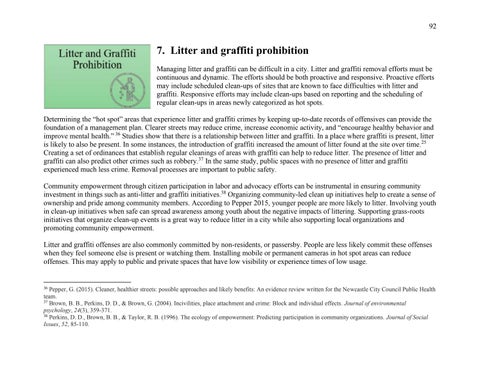92
7. Litter and graffiti prohibition Managing litter and graffiti can be difficult in a city. Litter and graffiti removal efforts must be continuous and dynamic. The efforts should be both proactive and responsive. Proactive efforts may include scheduled clean-ups of sites that are known to face difficulties with litter and graffiti. Responsive efforts may include clean-ups based on reporting and the scheduling of regular clean-ups in areas newly categorized as hot spots. Determining the “hot spot” areas that experience litter and graffiti crimes by keeping up-to-date records of offensives can provide the foundation of a management plan. Clearer streets may reduce crime, increase economic activity, and “encourage healthy behavior and improve mental health.” 36 Studies show that there is a relationship between litter and graffiti. In a place where graffiti is present, litter is likely to also be present. In some instances, the introduction of graffiti increased the amount of litter found at the site over time.25 Creating a set of ordinances that establish regular cleanings of areas with graffiti can help to reduce litter. The presence of litter and graffiti can also predict other crimes such as robbery.37 In the same study, public spaces with no presence of litter and graffiti experienced much less crime. Removal processes are important to public safety. Community empowerment through citizen participation in labor and advocacy efforts can be instrumental in ensuring community investment in things such as anti-litter and graffiti initiatives.38 Organizing community-led clean up initiatives help to create a sense of ownership and pride among community members. According to Pepper 2015, younger people are more likely to litter. Involving youth in clean-up initiatives when safe can spread awareness among youth about the negative impacts of littering. Supporting grass-roots initiatives that organize clean-up events is a great way to reduce litter in a city while also supporting local organizations and promoting community empowerment. Litter and graffiti offenses are also commonly committed by non-residents, or passersby. People are less likely commit these offenses when they feel someone else is present or watching them. Installing mobile or permanent cameras in hot spot areas can reduce offenses. This may apply to public and private spaces that have low visibility or experience times of low usage.
36
Pepper, G. (2015). Cleaner, healthier streets: possible approaches and likely benefits: An evidence review written for the Newcastle City Council Public Health team. 37 Brown, B. B., Perkins, D. D., & Brown, G. (2004). Incivilities, place attachment and crime: Block and individual effects. Journal of environmental psychology, 24(3), 359-371. 38 Perkins, D. D., Brown, B. B., & Taylor, R. B. (1996). The ecology of empowerment: Predicting participation in community organizations. Journal of Social Issues, 52, 85-110.




























